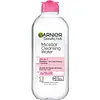What's inside
What's inside
 Key Ingredients
Key Ingredients

No key ingredients
 Benefits
Benefits

 Concerns
Concerns

No concerns
 Ingredients Side-by-side
Ingredients Side-by-side

Water
Skin ConditioningDipropylene Glycol
HumectantPEG-12 Laurate
EmulsifyingButylene Glycol
HumectantPEG/PPG/Polybutylene Glycol-8/5/3 Glycerin
HumectantPEG-8
HumectantPEG-6 Caprylic/Capric Glycerides
EmulsifyingPhenoxyethanol
PreservativeSodium Citrate
BufferingSodium Methyl Stearoyl Taurate
CleansingCitric Acid
BufferingMethyl Ethylcarbamate
Skin ConditioningDisodium EDTA
Ascorbic Acid
AntioxidantO-Cymen-5-Ol
AntimicrobialAlcohol
AntimicrobialCamellia Sinensis Leaf Extract
AntimicrobialWater, Dipropylene Glycol, PEG-12 Laurate, Butylene Glycol, PEG/PPG/Polybutylene Glycol-8/5/3 Glycerin, PEG-8, PEG-6 Caprylic/Capric Glycerides, Phenoxyethanol, Sodium Citrate, Sodium Methyl Stearoyl Taurate, Citric Acid, Methyl Ethylcarbamate, Disodium EDTA, Ascorbic Acid, O-Cymen-5-Ol, Alcohol, Camellia Sinensis Leaf Extract
 Reviews
Reviews

Ingredients Explained
These ingredients are found in both products.
Ingredients higher up in an ingredient list are typically present in a larger amount.
Disodium EDTA plays a role in making products more stable by aiding other preservatives.
It is a chelating agent, meaning it neutralizes metal ions that may be found in a product.
Disodium EDTA is a salt of edetic acid and is found to be safe in cosmetic ingredients.
Learn more about Disodium EDTAWater. It's the most common cosmetic ingredient of all. You'll usually see it at the top of ingredient lists, meaning that it makes up the largest part of the product.
So why is it so popular? Water most often acts as a solvent - this means that it helps dissolve other ingredients into the formulation.
You'll also recognize water as that liquid we all need to stay alive. If you see this, drink a glass of water. Stay hydrated!
Learn more about Water